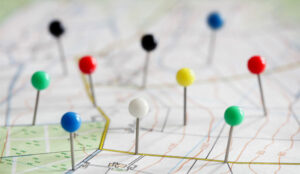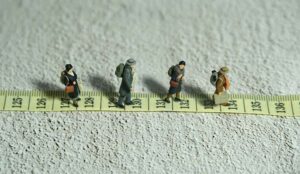We are often asked a range of customer journey mapping questions. Here we have provided some simple answers to your most common queries.
These answers come from Amy Scott, a service designer and customer experience consultant, who has worked with brands such as Toyota, Aegon and Western Union.
What Is a Customer Journey Map?
A customer journey map illustrates the steps that a customer makes in trying to accomplish a specific goal or task.
It could be to buy something, return something, get help, make a payment or a complaint.
For every customer objective like this, an organization can create a customer journey map.
How Does It Differ From a Customer Life Cycle Map?
Customers will need to do different things across various stages of their relationship with a business.
A customer life cycle map will therefore consist of several specific customer journeys, which cover the entire end-to-end experience that a customer has with your organization.
For example, a customer life cycle may include the following journeys:
- An onboarding journey
- A buying journey
- A returns journey
- A complaints journey
- A renewal/re-engagement journey
- A leaving journey
There exists some confusion between journey maps and process maps. However, a process map will sit behind different points of the customer journey and dictate how they can be achieved operationally.
A customer journey map will take more of an outside-in, customer-focused perspective of their journey.
For more on the difference between customer journey and process maps, read our article: 6 Ideas for Customer Journey Mapping
Why Are Customer Journey Maps So Important?
A customer journey map helps you to intentionally design the interactions that occur between you and your customers.
In creating these maps, you can get to grips with what customers want when interacting with your organization and plan journeys to match their ideal experience.
In doing so, you can make the services that you offer more useful and easier to use and more pleasurable.
A customer journey map will also help you to clarify, illustrate and communicate to the entire organization:
- What customers want at each stage of their interaction with an organization
- How you are currently delivering against these customer expectations
- Where the customer pain points are and what causes them
- How and where can you unexpectedly delight customers
This point on communication is key. If you can use your maps to align each department behind common goals, you can greatly enhance communication across the business.
Where Do Personas Fit Into the Mapping Process?
To be able to create more effective customer journey maps, you need to really understand what drives and influences your customers’ decisions.
This is where personas come in.
Personas are a useful way for understanding the motivations that support customer decisions and the experiences that they expect.
Built on observations of actual customers, you can create personas to represent classic “types” of customer, based on:
- How they interact with organizations
- Their needs
- Their goals
- Their behaviours
- Their demographic
- Sociographic information
The best customer journeys are created by meeting the needs of these personas, otherwise these journeys risk being too generic and not really meeting anybody’s needs or expectations.
Usually, the best customer journey maps are designed with a specific persona in mind, and typically businesses or brands have between four to eight different persona types.
Who Should Be Involved in Mapping the Customer Journey?
If you have a customer experience and insights team, they should lead this process. It is, however, also important to include every department that is involved in delivering the journey that you are designing.
Typically, this will include people from customer service, sales, marketing, digital, operations, logistics, finance, legal, etc.
Don’t overlook certain departments. Everyone has their part to play in delivering that journey and, if you involve them from the start, you will be in a much better position to achieve your goals.
Another important point is to do your best to include people in senior positions, as they may be able to secure stakeholder buy-in and the budget to help you to deliver the ideal customer journey.
Finally, you may also want to include external partners who have a role within your journey too.
How Much Time Does It Take to Create a Customer Journey Map?
With all of your research and insights to hand, it typically takes six to nine weeks to complete a good customer journey map.
Why does it take so long? Because to develop a useful map, it is best to follow this four-stage process:
Stage 1 – Uncover the “As Is” Journey (2–3 Weeks)
Create a customer journey map that represents what you currently do. This will act as a baseline.
Then, test your customer journey map with other departments and people who were not involved in the creation and incorporate their feedback.
Stage 2 – Create a “To Be” Journey (2–3 Weeks)
Your “To Be” journey map will address all of the pain points that you discovered in stage 1.
Again, you then test it with other departments and people who were not involved in the creation and incorporate their feedback.
Doing so can be highly beneficial as you gain an idea of how feasible it is to:
- Implement your ideas
- Meet proposed timescales
- Access the required resources
Stage 3 – Test (2–3 Weeks)
Test your new journeys with customers, ideally in focus groups.
With the feedback that you gather, refine your journey map and check the feasibility of your proposed changes.
Stage 4 – Launch and Monitor
Launch and continuously assess the impact your new journey has had on key performance indicators (KPIs).
Don’t stop monitoring after the first few weeks. After all, a customer journey map is not a “one and done” type of activity.
Keep tabs on how it is working and tweak it to improve it as time goes on.
A customer journey map is never finished. New competitors come along, customer expectations shift and market conditions change. Today’s ceiling can quickly become tomorrow’s floor.
So, keep an eye and ear on what is happening by getting a constant flow of feedback from both customers and frontline employees to continuously update your maps.
Remember, it is an iterative process that gets better over time.
What Research Do I Need to Have to Create a Customer Journey Map?
The first step is to review your existing data – both quantitative and qualitive. This may include:
- Employee surveys and feedback
- Voice of the Customer research
- Complaints related to the customer journey
- Channel data – i.e. which channels are involved in this journey?
- Customer churn and retention data
- Communication records – i.e. response/open rates
- Social media and review site comments
- Competitor analysis
- Mystery shopping data
Having gathered and analysed this information, run gap analysis to identify any additional research required to fill the gaps or get greater understanding of the current situation.
Next, consider undertaking some ethnographic research and observe people to see how they actually do things, such as navigate the website.
After all, what people say and what they do is sometimes very different!
You can now bring together all of this information and see what common themes appear, helping to surface some key pain points and drivers of delight along your existing customer journey.
How Can I Best Run a Customer Journey Mapping Session?
Get the right people in the room, establish that the journey must be looked at from an outside-in perspective and have a pile of post-it notes at the ready.
Then, to begin mapping the existing journey, agree on who the persona is and what will trigger the customer to begin their journey.
With this established, consider every step along the customer journey, in terms of:
- The back story
- What the customer wants
- The customer’s emotions
- The channels used
- What is enabling customers in achieving their goals
- What is preventing customers from achieving their goals
The key to doing this well is to make sure that you have gathered customer verbatim for every step.
At this point you can add the customer verbatim related to each journey step, discussing pain points along the way and establishing root causes. This way you can ensure you address the issues and design them out of your service when you create your new customer journey map.
At this point, call it a day but provide with everyone an output from the session and ask them to look at it individually over the next few days. They can then discuss it with colleagues in their respective departments and come up with ways to improve.
Gather everyone back together in another half-day workshop and get them to review and amend the customer journey map that they created.
Find out how you can calculate emotion by reading our article: How to Measure Customer Emotion
What Are the Best Customer Journey KPIs?
Too many customer experience initiatives fail because there are not clear and measurable goals put in place at the outset.
So, set your goals – which will likely be related to either reducing costs or business growth – and set KPIs in accordance with these to help measure the success of your customer experience programme.
While some of these KPIs will overlap, typically if you are looking to reduce costs, you will look to:
- Reduce complaints
- Improve First Contact Resolution (FCR)
- Reduce churn
- Lower cost to serve
- Reduce abandoned shopping carts
- Reduce failure demand
If you are instead looking to increase business growth, that can be measured by:
- Improvements in Net Promoter Score (NPS)
- Reduction in customer effort
- Increase in positive social media reviews
- Customer referrals
- Positive sentiment/emotions
- Customers buying more frequently or buying additional services
- Increase in customer lifetime value
Which of these KPIs you use really depends on the individual journey that you are designing.
How Does Customer Journey Analytics Differ From Customer Journey KPIs?
Customer journey analytics is really all about channels. It involves joining together information across every touchpoint and channel that a customer interacts with you on.
Over time, you can use this information to create a 360-degree view of the customer’s interaction history.
This 360-degree view helps you identify where there are issues on the customer’s cross-channel journey and possible causes, so you can take corrective action to improve it.
If you take the right actions, you can reduce friction and deliver a better experience, which can reduce churn and grow revenue.
To find out more about this type of analytics, read our article: What Is Customer Journey Analytics and How Can It Benefit Your Organization?
Where Can I Find an Example of a Simple Customer Journey Map?
There are lots of great examples of customer journey maps as well as free templates from a variety of organizations such as Kerry Bodine & Company.
Just Google “Customer Journey Map Examples” or “Customer Journey Map Templates” and you’ll find some good examples.

Amy Scott
One good example of IKEA’s customer journey map can be found in our article: Improve Customer Experience: 5 Strategies That You NEED to Try
What Are Your Favourite Customer Journey Quotes?
For me, it has to be the words of the late great Maya Angelou, when she described what you remember in life, which I think really helps to describe a customer journey……
I’ve learned that people will forget what you said, people will forget what you did, but people will never forget how you made them feel.
Thanks to Amy Scott for answering our questions. If you want to find out more from Amy, check out her customer insight-driven consultancy: Sedulous Consulting.
To find out more about creating great customer journeys, read our articles:
- 5 Steps to Creating a Customer Journey Map
- How to Use Customer Feedback to Improve Journey Maps
- How to Reduce Friction and Add Rewards to the Customer Experience
Author: Robyn Coppell
Published On: 31st May 2021
Read more about - Customer Service Strategy, Customer Journey



































